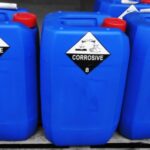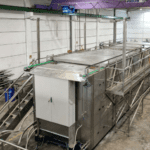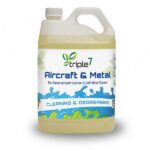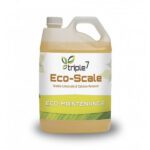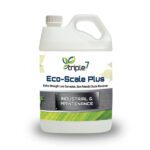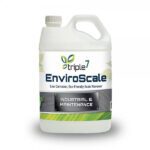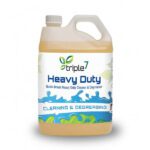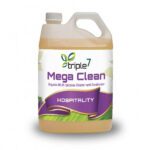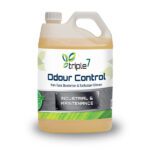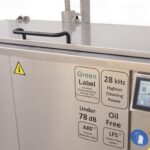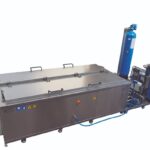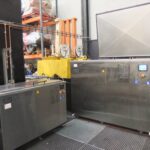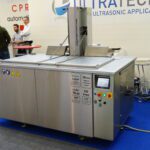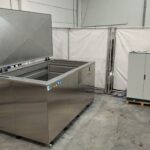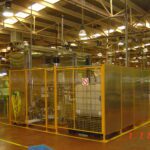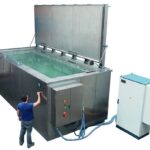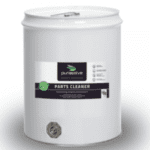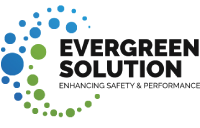The Growing Threat of AMR in Pharma Manufacturing
Antimicrobial resistance (AMR) has become one of the most pressing global health challenges, and pharmaceutical manufacturing plays a critical role in either mitigating or exacerbating this problem. As pathogens evolve and develop resistance to antimicrobial treatments, ensuring contamination-free drug production is more important than ever. One of the key contributors to AMR is the persistence of microbial residues and biofilms on pharmaceutical manufacturing equipment, which can lead to cross-contamination, reduced drug efficacy, and even regulatory non-compliance.
Understanding the Role of Contamination in AMR
Contamination in pharmaceutical manufacturing can occur at various stages, from raw material processing to final drug formulation. Even trace amounts of microbial residues can create an environment where bacteria thrive, leading to biofilm formation. Biofilms are structured communities of microorganisms encased in a protective matrix that makes them highly resistant to traditional cleaning and disinfection methods. When these biofilms persist on surfaces such as stainless steel tanks, reactors, and mixing equipment, they can act as reservoirs for drug-resistant bacteria.
The pharmaceutical industry operates under stringent regulations, requiring manufacturers to maintain the highest levels of hygiene. However, the challenge lies in ensuring that every surface, including complex geometries and microscopic crevices, is completely free from residues. If cleaning processes are not optimized, lingering microbial contaminants can gradually adapt to antimicrobial agents, accelerating the development of AMR.
How Ineffective Cleaning Contributes to Biofilm Formation and Cross-Contamination
Traditional cleaning methods, such as manual scrubbing, chemical cleaning, and Clean-in-Place (CIP) or Sterilize-in-Place (SIP) systems, have limitations when it comes to eliminating biofilms. These methods often struggle to reach microscopic contaminants, especially in equipment with complex internal structures, small cavities, and intricate piping systems. Incomplete removal of residues leaves behind organic matter that acts as a breeding ground for resistant microorganisms.
Cross-contamination is another major concern in pharmaceutical manufacturing. If equipment is not thoroughly cleaned between production cycles, residual microbes can be transferred from one batch to another, compromising product integrity. This not only affects drug quality but can also result in costly recalls, regulatory penalties, and reputational damage for pharmaceutical companies.
Why Traditional Cleaning Methods May Not Be Enough
While CIP and SIP systems are widely used for large-scale cleaning operations, they often rely on high volumes of water, aggressive chemical agents, and extensive validation processes. These methods can be effective for general cleaning but may not fully eliminate biofilms and microscopic residues that contribute to AMR. Additionally, the reliance on harsh chemicals increases environmental impact and operational costs.
Manual cleaning, though still employed in certain scenarios, is highly inconsistent and labor-intensive. The effectiveness of manual cleaning depends on human effort, making it prone to variability and increasing the risk of contamination. The industry needs a more efficient, automated, and precise cleaning solution that ensures complete residue removal without excessive resource consumption.
Introduction to Sonicator as Solutions
To address the limitations of traditional cleaning methods, pharmaceutical manufacturers are increasingly turning to ultrasonic cleaning technology. Sonication, which uses high-frequency sound waves to create microscopic cavitation bubbles, offers a superior approach to contamination control. These bubbles generate intense energy, effectively dislodging even the most stubborn biofilms and particulate matter from equipment surfaces.
A sonicator bath provides a uniform cleaning environment, ensuring that all submerged components receive thorough exposure to cavitation forces. This method is particularly beneficial for cleaning intricate parts, such as tubing, precision glassware, and filtration components. Industrial sonicators, designed for large-scale pharmaceutical applications, offer automated and high-capacity cleaning solutions for reactors, mixers, and blenders, ensuring consistent, repeatable cleaning outcomes.
By integrating sonication into pharmaceutical cleaning workflows, manufacturers can achieve a higher level of contamination control, reduce biofilm-related risks, and ensure compliance with regulatory standards. The adoption of ultrasonic cleaning represents a proactive step toward safeguarding pharmaceutical production against AMR while optimizing efficiency and sustainability.
The Hidden Risks of Residues in Pharmaceutical Manufacturing
Pharmaceutical manufacturing demands an uncompromising level of cleanliness, yet even trace amounts of residues can pose significant risks. Residues from active pharmaceutical ingredients (APIs), excipients, and microbial contaminants can accumulate on processing equipment, leading to unexpected chemical reactions, biofilm formation, and compromised product integrity. If not effectively removed, these residues can trigger regulatory violations, product recalls, and in severe cases, pose risks to patient health.
The Role of Residues in Cross-Contamination and Product Failure
Cross-contamination is one of the most critical concerns in drug production, particularly in facilities handling multiple products or batch processes. When residues from one production cycle persist into the next, they can lead to unintended chemical interactions. This not only affects drug stability and potency but can also result in the presence of unapproved substances in medications. Such contamination risks are especially concerning in the production of sterile injectables, biologics, and high-potency drugs, where even minute contamination can lead to adverse patient reactions.
Residue accumulation is not always immediately visible. Powdered pharmaceutical ingredients, residual solvents, and fine particulate matter can adhere to processing equipment in layers, gradually increasing contamination risks over time. Traditional visual inspection methods are often insufficient to detect these contaminants, making thorough and automated cleaning a necessity rather than an option.
Biofilms: A Persistent Threat in Pharmaceutical Equipment
Beyond chemical residues, microbial contamination presents an even more complex challenge. In pharmaceutical manufacturing environments, bacteria and fungi can attach to equipment surfaces and form biofilms—dense, highly resistant microbial communities encased in a self-produced protective matrix. These biofilms are particularly difficult to remove because they can withstand harsh chemical cleaning agents and persist through multiple cleaning cycles.
Once biofilms establish themselves, they can continuously shed microorganisms into production batches, leading to microbial contamination of drugs. This is especially problematic in the production of antibiotics and sterile pharmaceuticals, where microbial presence must be minimized to meet stringent regulatory standards.
Case Study: A Costly Recall Due to Insufficient Cleaning
A leading pharmaceutical manufacturer faced a major setback when one of its best-selling antibiotics was recalled due to microbial contamination. Investigations revealed that residual organic matter left on mixing tanks provided an ideal environment for bacterial growth. Despite routine cleaning, the persistence of biofilms resulted in contamination across multiple batches. The recall not only led to financial losses but also resulted in reputational damage and regulatory scrutiny.
This case underscores the critical need for effective residue removal strategies. Ensuring complete elimination of both chemical and microbial residues requires advanced cleaning solutions that penetrate deep into equipment surfaces, eliminating contaminants at a microscopic level.
Analytical Approach to Residue Detection and Removal
Achieving residue-free pharmaceutical manufacturing is not solely about cleaning—it is about understanding, measuring, and validating cleanliness at a microscopic level. An analytical approach ensures that all residues, whether chemical or microbial, are not just visually eliminated but quantitatively assessed for compliance with regulatory standards.
Defining Residue Limits: Setting Measurable Benchmarks
Regulatory bodies like the FDA and EMA require pharmaceutical manufacturers to establish acceptable residue limits for their equipment. This is determined based on:
- The toxicity and potency of the active pharmaceutical ingredients (APIs).
- The solubility and adhesion properties of residual compounds.
- The risk of carryover into subsequent batches.
Defining these limits involves precise calculations using techniques like the Maximum Allowable Carryover (MACO) method, which ensures that any potential residue remains well below toxicologically significant levels.
Advanced Analytical Techniques for Residue Detection
Detection is the foundation of an effective cleaning validation program. Several high-precision analytical methods help quantify residues on pharmaceutical processing equipment:
- High-Performance Liquid Chromatography (HPLC): Used to detect and quantify trace amounts of APIs and excipients in rinse samples.
- Total Organic Carbon (TOC) Analysis: Measures residual organic matter, providing a broad assessment of potential contaminants.
- Fourier Transform Infrared Spectroscopy (FTIR): Identifies specific chemical bonds, helping detect stubborn residues that might escape standard cleaning protocols.
- Surface Swab Testing: Direct sampling of equipment surfaces to ensure thorough residue removal in hard-to-reach areas.
Each of these methods provides critical data, helping manufacturers refine their cleaning processes to ensure regulatory compliance and absolute cleanliness.
Data-Driven Validation: Proving Cleaning Efficacy
Beyond detection, pharmaceutical manufacturers must validate that their cleaning protocols achieve consistent, reproducible results. This involves:
- Cleaning Process Qualification (CPQ): Running multiple cleaning cycles and measuring residue levels to ensure effectiveness.
- Statistical Process Control (SPC): Using trend analysis to identify variations and optimize cleaning efficiency.
- Documentation and Traceability: Maintaining rigorous records of cleaning validation to meet audit and compliance requirements.
By integrating analytical testing with process validation, manufacturers can move beyond trial-and-error cleaning and establish a science-backed, repeatable cleaning strategy that guarantees pharmaceutical-grade precision.
Implementing Sonication for Residue-Free Cleaning in Pharma Manufacturing
Integrating sonicator technology into pharmaceutical cleaning workflows is not just about switching to a new method—it requires strategic planning, process optimization, and validation. A well-designed sonicator bath or industrial sonicator setup can dramatically improve residue removal, but its effectiveness depends on proper implementation.
Step 1: Selecting the Right Sonicator for the Application
Not all sonicators are created equal, and selecting the right type depends on factors such as:
- Size and Geometry of Equipment Components: Large pharmaceutical mixers, blenders, and bioreactors require industrial sonicators, whereas smaller parts like glassware, filters, and tubing may only need a sonicator bath.
- Material Compatibility: Pharmaceutical equipment is often made of stainless steel, glass, or specialized polymers. The ultrasonic cleaning solution used must be compatible with these materials to prevent degradation.
- Contamination Type: Sonication parameters (such as frequency and power) should be selected based on the types of residues encountered—whether protein-based biofilms, powder residues, or chemical films.
Step 2: Optimizing Cleaning Parameters for Maximum Efficiency
To ensure consistent and effective residue removal, key parameters must be optimized:
- Frequency Selection:
- Low-frequency sonicators (20-40 kHz): Best for heavy-duty cleaning of metal components.
- Mid-range frequencies (40-80 kHz): Ideal for general pharmaceutical cleaning applications.
- High frequencies (80-130 kHz): Used for delicate instruments and micro-residues, ensuring fine particulate removal.
- Time and Temperature Control:
- Excessive sonication time can cause material damage, while insufficient time may leave residues.
- Heat enhances cleaning efficiency but must be regulated to avoid degrading sensitive materials.
- Degassing the Cleaning Solution:
- Before use, ultrasonic baths should be degassed to remove air bubbles that can interfere with cavitation.
Step 3: Integrating Sonication into the Cleaning Workflow
Pharmaceutical cleaning workflows must be carefully structured to ensure seamless sonicator integration. This includes:
- Pre-Cleaning Rinse: To remove loose contaminants before sonication.
- Ultrasonic Cleaning Cycle: Ensuring appropriate frequency, temperature, and solution chemistry.
- Post-Sonication Rinse: Using purified water to remove any residual cleaning agents.
- Drying and Final Inspection: Ensuring surfaces are completely residue-free.
Step 4: Validation and Compliance Documentation
For pharmaceutical manufacturers, meeting FDA, GMP, and ISO 13485 compliance is non-negotiable. This requires:
- Cleaning Validation Studies: Measuring residues before and after sonication.
- Qualification Testing: Running Installation Qualification (IQ), Operational Qualification (OQ), and Performance Qualification (PQ) on sonicator systems.
- Process Monitoring & Data Logging: Ensuring repeatability and traceability in cleaning cycles.
By systematically implementing sonicator technology with precise validation, pharmaceutical manufacturers can achieve residue-free cleaning, minimize antimicrobial resistance risks, and maintain compliance with global regulatory standards.
Monitoring and Validating the Effectiveness of Sonication in Pharmaceutical Cleaning
The successful adoption of sonicator technology in pharmaceutical manufacturing depends on rigorous monitoring and validation. Regulatory agencies such as the FDA, GMP, and ISO 13485 emphasize that cleaning processes must be scientifically validated, ensuring that no residual contaminants remain. Pharmaceutical companies must implement a structured approach to evaluating and confirming the efficiency of sonicator baths and industrial sonicators to meet compliance requirements.
Step 1: Establishing Baseline Contamination Levels
Before implementing sonication, manufacturers must first assess baseline contamination levels on equipment surfaces. This involves:
- Surface Swab Testing: Collecting samples from reactors, blenders, and tubing to analyze microbial and chemical residues.
- TOC (Total Organic Carbon) Analysis: Measuring organic residue levels to establish contamination benchmarks.
- Visual Inspection: Using high-powered microscopy or fluorescence techniques to detect microscopic residues.
By establishing a pre-cleaning contamination profile, companies can determine the effectiveness of ultrasonic cleaning in removing specific contaminants.
Step 2: Defining Key Validation Metrics
To ensure consistent and effective performance, manufacturers should establish clear validation parameters, including:
- Residue Removal Efficiency: Measuring pre- and post-sonication residue levels to verify complete cleaning.
- Cavitation Uniformity: Ensuring even distribution of ultrasonic energy across all components.
- Cleaning Solution Integrity: Monitoring pH, conductivity, and microbial content to confirm solution effectiveness.
- Process Repeatability: Running multiple cleaning cycles to confirm reproducibility under identical conditions.
These metrics allow manufacturers to determine whether sonicator baths and industrial sonicators consistently meet cleaning expectations.
Step 3: Qualification and Regulatory Documentation
Validation is a multi-step process that ensures sonicator-based cleaning meets strict regulatory guidelines. Pharmaceutical companies should follow the IQ/OQ/PQ (Installation, Operational, and Performance Qualification) framework:
- Installation Qualification (IQ):
- Verifying the sonicator’s correct installation and configuration.
- Confirming that components (transducers, tanks, power supply) meet manufacturer specifications.
- Operational Qualification (OQ):
- Testing various frequencies and cycle times to determine optimal cleaning parameters.
- Assessing temperature control and cavitation efficiency.
- Performance Qualification (PQ):
- Conducting real-world cleaning cycles on pharmaceutical equipment.
- Using analytical methods (such as HPLC, FTIR) to confirm residue-free surfaces.
Proper documentation of IQ/OQ/PQ validation ensures compliance with FDA, GMP, and ISO 13485 requirements.
Step 4: Implementing Continuous Monitoring Systems
Once validated, sonicator-based cleaning must be continuously monitored to maintain efficiency. This includes:
- Periodic Residue Testing: Regular testing to confirm no buildup of contaminants.
- Cavitation Performance Checks: Ensuring ultrasonic transducers function optimally.
- Solution Change Intervals: Monitoring degradation of cleaning solutions over time.
By implementing real-time monitoring, manufacturers can proactively address any deviations in cleaning performance.
Conclusion
Monitoring and validating sonicator technology in pharmaceutical cleaning ensures compliance, repeatability, and effectiveness. With rigorous qualification and ongoing assessment, pharmaceutical companies can confidently integrate sonicator baths and industrial sonicators into their manufacturing workflows, achieving residue-free cleaning and reducing antimicrobial resistance risks.
Best Practices for Implementing Sonication in Pharma Manufacturing
The implementation of sonicator-based cleaning in pharmaceutical manufacturing requires careful planning and adherence to industry best practices. While sonication offers unparalleled efficiency in removing microscopic contaminants, its effectiveness depends on several key factors, including proper equipment selection, optimized cleaning protocols, and personnel training. This section provides a structured approach to integrating sonicator baths and industrial sonicators into pharmaceutical cleaning workflows.
- Selecting the Right Sonicator for Pharma Applications
The choice of sonicator depends on the type of pharmaceutical equipment being cleaned, the nature of contaminants, and compliance requirements. Factors to consider when selecting a sonicator bath or industrial sonicator include:
- Frequency Range: Lower frequencies (20-40 kHz) are effective for heavy contaminants, while higher frequencies (80-130 kHz) are ideal for delicate components such as glassware and precision tubing.
- Tank Capacity: The size of the sonicator bath must accommodate reactors, mixers, or medical device components without overcrowding.
- Material Compatibility: Pharmaceutical-grade stainless steel sonicators with inert tank linings prevent contamination from metallic ion leaching.
- Filtration & Degassing Features: Built-in filtration systems remove detached residues, while degassing improves cavitation efficiency.
Proper selection ensures that the sonicator cleaning process aligns with both regulatory standards and operational requirements.
- Optimizing Sonication Parameters for Maximum Cleaning Efficiency
For sonicator-based cleaning to achieve full contaminant removal, cleaning parameters must be optimized. Key variables include:
- Temperature Control: Most pharmaceutical contaminants, including biofilms and drug residues, break down efficiently at 40-60°C. Excessive temperatures can degrade heat-sensitive components.
- Detergent Selection:
- Enzymatic Cleaners: Best for protein-based residues.
- Alkaline Solutions: Effective for fatty deposits and oils.
- Neutral pH Solutions: Safe for delicate components like chromatography columns.
- Cleaning Cycle Duration:
- Small lab tools: 5-10 minutes
- Process equipment parts: 15-30 minutes
- High-contamination components: 30+ minutes
- Ultrasonic Power Settings: Power output must match contamination levels—higher power for stubborn residues, lower power for precision cleaning.
Adjusting these parameters ensures optimal use of industrial sonicators without risking equipment damage.
- Developing Standard Operating Procedures (SOPs) for Sonicator Use
To maintain consistency and compliance, SOPs should be established for sonicator bath operations. These procedures should cover:
- Pre-Cleaning Steps: Manual removal of large debris before placing items in the sonicator bath.
- Loading Guidelines: Components should be fully submerged but not overcrowded, ensuring even cavitation exposure.
- Post-Sonication Rinsing: Using pharmaceutical-grade filtered water or ultrapure water to remove detergent residues.
- Drying & Storage: Ensuring complete drying to prevent moisture-related contamination.
SOPs provide operational consistency, ensuring that pharmaceutical-grade cleaning meets regulatory standards.
- Training & Qualification of Personnel
Effective use of sonicator technology requires specialized training to ensure compliance, safety, and performance consistency. Training programs should include:
- Understanding Ultrasonic Cavitation: Employees must understand how sonication breaks down contaminants.
- Operating Protocols: Step-by-step guidance on loading, setting parameters, and verifying cleaning cycles.
- Troubleshooting & Maintenance: Identifying common issues (e.g., cavitation loss, transducer failure) and performing preventive maintenance.
- Regulatory Awareness: Educating personnel on FDA, GMP, and ISO 13485 cleaning validation requirements.
Trained personnel can ensure sonicator baths and industrial sonicators function optimally while maintaining compliance.
- Establishing a Maintenance & Calibration Schedule
To prevent equipment degradation and ensure consistent performance, a structured maintenance plan must be implemented. Maintenance routines should include:
- Daily Checks: Verifying liquid levels, filtration systems, and detergent concentrations.
- Weekly Performance Testing: Conducting foil tests to confirm uniform cavitation across the sonicator bath.
- Monthly Calibration: Adjusting ultrasonic power output to prevent efficiency drift over time.
- Annual Regulatory Audits: Ensuring industrial sonicators meet compliance requirements through independent validation testing.
Regular maintenance and calibration help maintain the long-term efficiency of pharmaceutical sonicator systems.
Conclusion: Precision Cleaning with Sonication – The Future of Pharma Manufacturing
The battle against antimicrobial resistance (AMR) and contamination in pharmaceutical manufacturing demands a shift toward precision cleaning technologies. Traditional cleaning methods, while effective for general applications, often fall short when dealing with biofilms, microscopic residues, and intricate equipment geometries. This is where sonicator-based cleaning provides a game-changing solution.
By leveraging the power of ultrasonic cavitation, sonicator baths and industrial sonicators ensure thorough removal of contaminants, even in the most complex pharmaceutical equipment. Unlike manual or chemical-based cleaning, sonication delivers consistent, repeatable, and validated cleaning results. With its ability to penetrate microscopic crevices, sonication is particularly effective for cleaning precision tools, reactor components, and medical device manufacturing equipment.
Moreover, regulatory compliance is no longer a challenge when using properly validated sonicator cleaning processes. With adherence to FDA, GMP, and ISO 13485 guidelines, pharmaceutical manufacturers can confidently integrate ultrasonic cleaning into their workflows while maintaining the highest industry standards.
For companies aiming to enhance their contamination control strategies, investing in sonicator-based cleaning is a step toward safer, more efficient, and regulation-compliant manufacturing. The key lies in choosing the right sonicator, optimizing parameters, training personnel, and implementing structured maintenance protocols.
Are you considering ultrasonic cleaning to achieve residue-free, compliant pharmaceutical cleaning? Our team of experts can help you select the right sonicator, develop validation protocols, and ensure seamless integration into your processes. Contact us today to explore customized ultrasonic cleaning solutions tailored to your needs!


